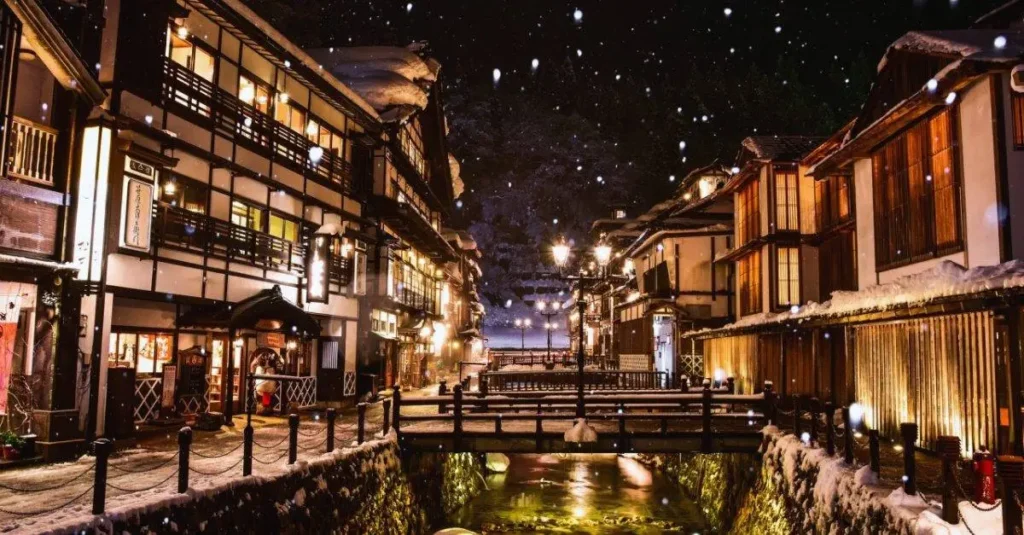Starting from January 7, 2025, the historic hot spring village of Ginzan Onsen, located in the mountainous region of Yamagata in northern Japan, began implementing a unique tourism restriction measure in response to the overtourism phenomenon that has been affecting various regions of the country. From this date onward, any visitor wishing to access the village after 5 p.m. will be required to purchase an advance ticket. This initiative aims to balance the need to preserve local tranquility with the sustainability of tourism, which has become increasingly challenging due to the growing number of tourists in recent years.
Ginzan Onsen is a small, traditional village known not only for its famous hot springs but also for its charming landscape, featuring old Edo-era buildings covered in snow during the winter, creating a magical, cinematic scene. The village, with a population of approximately 300 residents, receives around 330,000 tourists annually from various parts of Japan and the world, drawn by the combination of therapeutic hot springs and the area’s natural beauty, which has become one of the country’s most visited destinations.

The tourism appeal of Ginzan Onsen has grown significantly in recent decades, especially among international tourists seeking an authentic, peaceful experience amidst nature. During the winter, the area transforms into a fairy-tale landscape, with snow-covered alleys and traditional ryokan (old-style Japanese inns) illuminated by lanterns casting mysterious shadows—a scene that has captured the imagination of millions of travelers. Rumors even suggest that the aesthetic of Ginzan Onsen may have inspired the creation of the magical world in the Oscar-winning film Spirited Away, directed by renowned animator Hayao Miyazaki, further increasing its popularity.
However, this rising popularity has brought a range of challenges for the local residents, who are under pressure to manage the influx of tourists in a town that has traditionally maintained a quiet life. Problems began to surface as visitor numbers continued to rise, bringing disruptive behaviors. Locals reported several incidents involving disputes over the best photo spots, congestion in narrow streets, inappropriate behavior, and disrespect for community and traffic rules. The area, once known for its serenity and peace, became a source of tension and discomfort for its inhabitants.
According to the local government, there have been reports of tourists becoming aggressive while vying for the best angles to photograph the snow-covered village, which led to altercations and even violations of traffic rules. Additionally, the lack of respect for local infrastructure resulted in practical problems, such as blocked parking spaces and difficulties accessing essential services. “Many visitors became frustrated when competing for the best photo spots, creating excessive noise and disrespecting established rules, creating an atmosphere of tension. This led to inappropriate behaviors, such as blocking streets and parking areas, and even dangerous situations, like near falls into the river due to a lack of care,” stated the Ginzan Onsen city hall on its official website.
In response to this situation, the introduction of a ticketing system was seen as a necessary measure to alleviate the growing pressure on the village and ensure that visitors can enjoy the area without negatively affecting the residents. Starting on January 7, tourists who wish to visit Ginzan Onsen after 5 p.m. will need to purchase an advance ticket, which includes bus transportation to the site, at a cost of 1,150 yen (about 8.50 USD). Additionally, the measure stipulates that visitors who have not made reservations at local hotels will be prohibited from accessing the village after 8 p.m. to control the number of tourists at night and avoid congestion in the narrow streets.
Another important measure is the restriction on the use of private cars. Tourists opting to travel by car will have to park in a tourism center located outside the village and take a public transportation shuttle to Ginzan Onsen. This change aims to reduce traffic congestion and ensure the safety of both tourists and residents. Hiroyuki Ishii, responsible for the Ginzan Onsen Overtourism Measures Project Office, explained that the roads leading to the village, often covered with snow in winter, have proven dangerous for drivers. The constant flow of cars on narrow streets has caused traffic jams, blocking access for ambulances, compromising the safety of residents and visitors. “With the snow covering the roads, many tourists end up getting stuck, creating traffic jams and blockages that prevent normal traffic, including access for emergency vehicles,” reported Ishii.
Ginzan Onsen is not alone in its battle against overtourism. Japan, which has experienced an unprecedented tourism boom in recent years, with 33 million foreign visitors by November 2024, surpassing the record of 31.9 million visitors set in 2019, has been implementing various initiatives to control the impact of tourism on historic and natural sites. Other popular tourist destinations in Japan have also begun to adopt similar measures, such as Fujikawaguchiko at the foot of Mount Fuji, which installed a black net to block the view from a tourist spot causing discomfort to locals. The net was removed after the crowding of tourists decreased, but the experience highlighted the urgent need for solutions to overtourism.
Additionally, Mount Fuji and Himeji Castle, Japan’s largest castle, are also considering raising entry fees for tourists as a way to control visitor numbers and ensure the preservation of these historic landmarks. These measures are part of a growing movement in Japan, where environmental and cultural preservation is becoming an increasingly important priority as the country seeks to balance the desire to promote tourism with the need to maintain the quality of life for its citizens and protect its natural resources.
These changes in Ginzan Onsen and other popular destinations reflect a growing global movement toward sustainable tourism solutions. The challenge, however, is finding a balance between preserving cultural and natural sites and the authentic experiences that tourists seek.
The measure adopted by Ginzan Onsen to limit tourist access during peak season is a clear reflection of the difficulties Japan and other popular destinations face in the face of overtourism. By seeking to balance the preservation of local heritage, the well-being of residents, and the experience of visitors, the country is adopting stricter practices to ensure that tourism remains a source of cultural and economic enrichment without compromising natural resources and the quality of life in communities. These actions also signal a growing global movement toward sustainable tourism, where responsible management becomes essential for preserving the world’s most cherished destinations. Ginzan Onsen, like other locations facing overtourism, demonstrates that it is possible to attract tourists while protecting sites, as long as careful and planned measures are implemented, ensuring that both heritage and visitors are respected. The future of tourism, therefore, depends on the ability to adopt balanced practices that favor harmony between sector growth and the sustainability of local cultures and environments.

